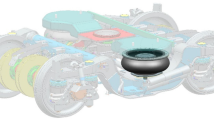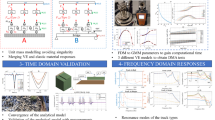Abstract
Purpose
The critical speed of a railway track is the speed at which the vibration occurs at the largest magnitude. Thus, its identification is necessary to prevent derailments and damage to the rail tracks. The present study attempted a three-dimensional finite element analysis of a typical ballasted rail track under a single moving wheel load at different speeds to evaluate the critical speed.
Methods
The track’s ballast, subballast, and subgrade layers (substructure) were modeled as elastoplastic material with material damping and radiation damping (infinite layers). Track response was recorded in the form of stress, displacement, velocity, and acceleration responses to identify the critical speed of the rail track. Different parameters were analyzed to find the critical speed, such as the method of applying moving load, the material model of the primary load-carrying layer (ballast), the effect of boundaries, and the type of data extracted from the output databases. Parametric studies were performed on material damping and stiffness of track substructure layers to see their effect on the track’s dynamic response. The effect of shear strength parameters (cohesion and friction) of the subgrade was also analyzed to examine their effect on the critical speed of the rail track.
Results and Conclusions
The study shows that the combination of vertical velocity, stress, and acceleration trends can be used to identify the critical speed of the rail track. Young’s moduli of substructure do not show direct proportionality with the critical speed. The damping ratio has a small but noticeable effect on the critical speed, while the increase in shear strength of the subgrade increases the critical speed. A phase-lag was observed as the speed transitions from subcritical to supercritical. The critical speed from the finite element analysis shows a good agreement with the shear and Rayleigh wave velocities calculated from empirical approximations.


















Similar content being viewed by others
References
Mallik AK, Chandra Sarvesh, Singh Avinash B (2006) Steady-state response of an elastically supported infinite beam to a moving load. J Sound Vib 291(3–5):1148–1169. https://doi.org/10.1016/j.jsv.2005.07.031
Feng H (2011) 3d-models of railway track for dynamic analysis. Master’s thesis, KTH Sweden, KTH Sweden. URL http://www.diva-portal.org/smash/get/diva2:467217/FULLTEXT01.pdf
Krylov VV, Dawson AR, Heelis ME, Collop AC (2000) Rail movement and ground waves caused by high-speed trains approaching track-soil critical velocities. Proc Instit Mech Eng, Part F: J Rail Rapid Transit 214(2):107–116. https://doi.org/10.1243/0954409001531379
Dimitrovová Z, Varandas JN (2009) Critical velocity of a load moving on a beam with a sudden change of foundation stiffness: Applications to high-speed trains. Comput Struct 87(19–20):1224–1232. https://doi.org/10.1016/j.compstruc.2008.12.005
Diego F, Egidio R, Fernando M.F. Sim oes, and António Pinto Da Costa (2018) Dynamics of a beam on a bilinear elastic foundation under harmonic moving load. Acta Mech, 229 (10): 4141–4165. https://doi.org/10.1007/s00707-018-2213-4
Kumawat Aditi, Raychowdhury Prishati, Chandra Sarvesh (2019) Frequency-Dependent Analytical Model for Ballasted Rail-Track Systems Subjected to Moving Load. Int J Geomech 19(4):04019016. https://doi.org/10.1061/(asce)gm.1943-5622.0001358
Shamsul B, Nasim A (2021) Development of low-frequency mass spring system for underground high-speed railways. J Vib Eng Technol. https://doi.org/10.1007/s42417-021-00392-w
X. Sheng, C. J.C. Jones, and D. J. Thompson ()2003 A comparison of a theoretical model for quasi-statically and dynamically induced environmental vibration from trains with measurements. J Sound Vib 267 (3): 621–635. ISSN 0022460X. doi: https://doi.org/10.1016/S0022-460X(03)00728-4
Sara BM, David PC, Peter KW, Omar L, Joao P, Pedro AC (2016) Railway critical velocity - Analytical prediction and analysis. Transp Geotech 6: 84–96. doi: https://doi.org/10.1016/j.trgeo.2015.09.002
Ernest N, Young HJ (2015) Dynamic subsoil responses of a stiff concrete slab track subjected to various train speeds: a critical velocity perspective. Comput Geotech 69: 7–21. doi: https://doi.org/10.1016/j.compgeo.2015.04.012
Meysam B, Peter W, Justin K, and Gabriela M (2013) Three-dimensional modelling of high speed ballasted railway tracks. Proc Inst Civil Eng: Transp 166 (2): 113–123. ISSN 0965092X. doi: https://doi.org/10.1680/tran.9.00048
Li Ling, Nimbalkar Sanjay, Zhong Rui (2018) Finite element model of ballasted railway with infinite boundaries considering effects of moving train loads and Rayleigh waves. Soil Dyn Earthq Eng 114:147–153. https://doi.org/10.1016/j.soildyn.2018.06.033
Bian Xuecheng, Cheng Chong, Jiang Jianqun, Chen Renpeng, Chen Yunmin (2016) Numerical analysis of soil vibrations due to trains moving at critical speed. Acta Geotech 11(2):281–294. https://doi.org/10.1007/s11440-014-0323-2
Sowmiya C, Shahu JT (2016) Reinforcement and mud-pumping benefits of geosynthetics in railway tracks: Numerical analysis. Geotext Geomembr 44 (3): 344–357. doi: https://doi.org/10.1016/j.geotexmem.2016.01.006
Pranjal M, J T Shahu, Sarvesh C (2022) An assessment of dynamic impact factors for ballasted track using finite element method and multivariate regression. J Vib Eng & Technol 1–15. doi: https://doi.org/10.1007/s42417-022-00507-x
RDSO (2009) Guidelines and Specifications for Design of Formation for Heavy Axle Load
UIC. 774-3R: 2001 Track/bridge interaction-Recommendations for calculations, 2001
Lysmer John, Kuhlemeyer Roger L (1969) Finite Dynamic Model for Infinite Media. J Eng Mech Div 95(4):859–877. https://doi.org/10.1061/jmcea3.0001144
Zienkiewicz OC, Emson C, Bettess P (1983) A novel boundary infinite element. Int J Numer Meth Eng 19(3):393–404. https://doi.org/10.1002/nme.1620190307
SIMULIA. Abaqus User Manual, 2009. URL http://130.149.89.49:2080/v6.14/books/usb/default.htm
Delfosse-Ribay Estelle, Djeran-Maigre Irini, Cabrillac Richard, Gouvenot Daniel (2004) Shear modulus and damping ratio of grouted sand. Soil Dyn Earthq Eng 24(6):461–471. https://doi.org/10.1016/j.soildyn.2004.02.004
Vakkalagadda MRK, Srivastava DK, Mishra A, Racherla V (2015) Performance analyses of brake blocks used by Indian Railways. Wear 328–329:64–76. https://doi.org/10.1016/j.wear.2015.01.044
Pranjal M, Shahu JT, Sarvesh C (2022) Numerical analysis on combinations of geosynthetically reinforced earth foundations for high-speed rail transportation. Structures 43: 738–751. doi: https://doi.org/10.1016/j.istruc.2022.07.003
Bowness D, Lock AC, Powrie W, Priest JA, Richards DJ (2007) Monitoring the dynamic displacements of railway track. Proce Inst Mech Eng , Part F: J Rail Rapid Transit 221(1):13–22. https://doi.org/10.1243/0954409JRRT51
Quinn AD, Hayward M, Baker CJ, Schmid F, Priest JA, Powrie W (2010) A full-scale experimental and modelling study of ballast flight under high-speed trains. Proc Inst Mech Eng, Part F: J Rail Rapid Transit 224(2):61–74. https://doi.org/10.1243/09544097JRRT294
Pranjal M, Shahu JT, Sarvesh C (2021) A parametric study of embedded slab track system for high-speed applications on cohesive subgrade. Transp Infrastruct Geotechnol. ISSN 21967210. doi: https://doi.org/10.1007/s40515-021-00206-2
Madshus C, Kaynia AM (2000) High-speed railway lines on soft ground: dynamic behaviour at critical train speed. J Sound Vib 231(3):689–701. https://doi.org/10.1006/jsvi.1999.2647
A. López Pita, P. F. Teixeira, and F. Robusté (2004) High speed and track deterioration: The role of vertical stiffness of the track. Proc Inst Mech Eng, Part F: J Rail Rapid Transit 218 (1): 31–40. doi: https://doi.org/10.1243/095440904322804411
Yin G, Hai H, Carlton LH, James PH (2017) High speed railway track dynamic behavior near critical speed. Soil Dyn Earthq Eng 101: 285–294. doi: https://doi.org/10.1016/j.soildyn.2017.08.001
Acknowledgements
The authors thank IIT Delhi High Performance Computing (HPC) facility for generously providing necessary computational resources.
Funding
The author(s) received no financial support for the research,authorship, and/or publication of this article.
Author information
Authors and Affiliations
Corresponding author
Ethics declarations
Conflict of Interest
The author(s) declared no potential conflicts of interest with respect to the research, authorship, and/or publication of this article.
Additional information
Publisher's Note
Springer Nature remains neutral with regard to jurisdictional claims in published maps and institutional affiliations.
Rights and permissions
Springer Nature or its licensor holds exclusive rights to this article under a publishing agreement with the author(s) or other rightsholder(s); author self-archiving of the accepted manuscript version of this article is solely governed by the terms of such publishing agreement and applicable law.
About this article
Cite this article
Mandhaniya, P., Shahu, J.T. & Chandra, S. Analysis of Dynamic Response of Ballasted Rail Track Under a Moving Load to Determine the Critical Speed of Motion. J. Vib. Eng. Technol. 11, 3197–3213 (2023). https://doi.org/10.1007/s42417-022-00741-3
Received:
Revised:
Accepted:
Published:
Issue Date:
DOI: https://doi.org/10.1007/s42417-022-00741-3




